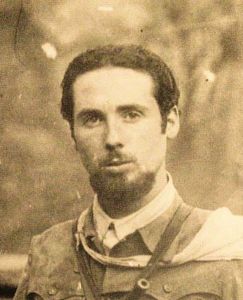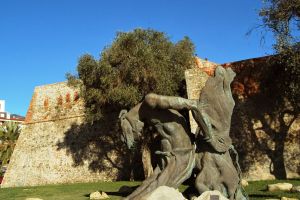Painter and Sculptor
 Renzo Orvieto was born in Turin on 20th April 1922. He graduated in musical composition, but soon dedicated himself to the activity of painter and sculptor. He was also a partisan fighter in Val Tanaro, in the province of Cuneo.
Renzo Orvieto was born in Turin on 20th April 1922. He graduated in musical composition, but soon dedicated himself to the activity of painter and sculptor. He was also a partisan fighter in Val Tanaro, in the province of Cuneo.
Almost all his activity as an artist, however, took place in Sanremo, the city where he moved with his atelier. Since the 1950s he has attracted the attention of national critics, holding solo exhibitions in various Italian cities. The most remarkable ones in Rome in 1970 and 1974. In the same year he also exhibited in Bologna and Perugia.
But his link with the years of the Resistance did not end with the war, on the contrary, thanks to the various sculptures and illustrations linked to the partisans and the theme of the Resistance, a large part of Orvieto's life was dedicated to the Resistance. Perhaps the most prestigious recognition for this activity, Orvieto obtained it from the municipality of Cuneo in the 30th Anniversary of the Liberation, which considers it the representative of the Art of Resistance.
The works of Renzo Orvieto vary from portraits to still life. He prefers older subjects, landscapes and autumn products and many works are dedicated to horses. The colours are often dark, with a preference for brown, green and grey. On the whole they are works that represent heroism and suffering, even if in recent years the decadence and the end of life, including the loneliness that comes with it, have become increasingly present. Most of the major works, however, are dedicated to the Resistance. The Municipality of Sanremo commissioned him the Monument to the Martyrs of the Resistance (inaugurated on 2 June 1972 along the Vittorio Veneto gardens). He also created the monument dedicated to the fallen of the Acqui Division in Cefalonia and Corfu, and the bronze effigy in the centre of the plaque dedicated to Italo Calvino.
The Municipality of Sanremo commissioned him the Monument to the Martyrs of the Resistance (inaugurated on 2 June 1972 along the Vittorio Veneto gardens). He also created the monument dedicated to the fallen of the Acqui Division in Cefalonia and Corfu, and the bronze effigy in the centre of the plaque dedicated to Italo Calvino.
He died in Sanremo on 28 February 1999.
On 27 September 2002 the Municipality of Sanremo, on the initiative of ANPI, dedicated the portico connecting Via Palazzo with Piazza Cassini to him.
(source Wikipedia)




